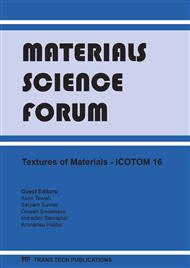p.651
p.655
p.659
p.663
p.667
p.673
p.677
p.681
p.685
Study of Micro-Texture during Recovery and Recrystallisation in Folded BCC and FCC Sheet Samples
Abstract:
The sheet folding process generates both tensile and compressive strains across the folded section, producing systematic strain and texture gradients. In this investigation the EBSD technique has been used to gain insight into this phenomenon in folded ferritic steel and nickel alloys, both in the as folded and after annealing conditions. As expected in the fcc material the {111} and {110} fibre texture components get reinforced in the tensile and compressive regions respectively, while the {110} and {111} components are reinforced in the bcc material during folding. After annealing at 600oC for 40 minutes the texture components formed during the folding process are retained despite the formation of new strain free grains. The new grains were found to be slightly larger in the tensile regions than in the compressed regions this was the case for both materials. However, in the mid-region of the section in the nickel alloy abnormal grain growth took place, while only recovery was observed in the ferritic alloy.
Info:
Periodical:
Pages:
667-670
Citation:
Online since:
December 2011
Authors:
Keywords:
Price:
Сopyright:
© 2012 Trans Tech Publications Ltd. All Rights Reserved
Share:
Citation:


